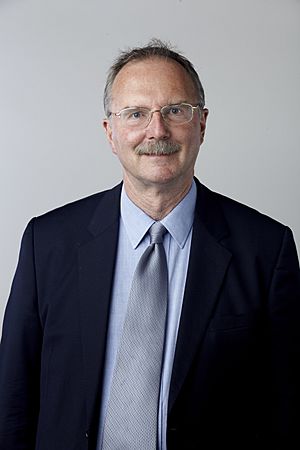Martin Hume Johnson facts for kids
Quick facts for kids
Martin Hume Johnson
FRS FMedSci FRSB FRCOG
|
|
|---|---|

Martin Johnson in 2014, portrait via the Royal Society
|
|
| Born | 19 December 1944 |
| Alma mater | University of Cambridge |
| Awards |
|
| Scientific career | |
| Fields |
|
| Institutions | University of Cambridge |
| Thesis | An immunochemical analysis of factors affecting fertility (1969) |
| Doctoral advisor | Robert Edwards (physiologist) |
Martin Hume Johnson, born in 1944, is a British scientist. He is a retired professor of Reproductive Sciences at the University of Cambridge. He worked in the Department of Physiology, Development and Neuroscience (PDN). His work focused on how living things reproduce and develop.
Contents
Early Life and Education
Martin Johnson went to Cheltenham Grammar School for Boys. He then studied at Christ's College, Cambridge. In 1969, he earned his PhD degree. His research looked at how the body's immune system affects the ability to have babies. This field is called immunochemistry.
Research and Discoveries
Professor Johnson's research explores the history of science. He studies how reproductive and developmental sciences have changed over time. He also looks at how these sciences relate to medical technologies. This includes the rules and ethics around them.
He works with other scientists like Kay Elder and Sarah Franklin. Together, they study these important topics.
Contributions to Science
Martin Johnson has written over 300 scientific papers. These papers cover many areas. They include reproductive science, developmental science, history, ethics, and medical education. His research has received funding from the Wellcome Trust.
One of his biggest discoveries was about how cells become organized. This happens very early in the development of mammals. He found that cells start to separate into different groups. One group forms the outer layer of the placenta. The placenta helps the baby grow inside the mother. The other group of cells forms the baby's body. His work laid the foundation for much of what we know today.
Understanding Early Development
Professor Johnson also helped us understand human reproduction. His work on mouse development showed the first steps of how an embryo forms. He studied when a baby's own genes start to become active. He also improved methods for freezing mouse eggs. This process is called cryopreservation.
His research also used genetically modified mice. He studied how certain cells, called glial cells, help the brain heal after injury. He also contributed to the rules and laws around reproductive medicine.
Awards and Recognition
Martin Johnson has received many important awards for his work.
Fellow of the Royal Society
In 2014, Johnson was elected a Fellow of the Royal Society (FRS). This is a very high honor for scientists in the UK. His nomination recognized his discovery of how cells become organized during early development. This discovery was key to understanding how the placenta and the baby's body form. His work changed how doctors approach reproductive medicine.
Fellow of the Academy of Medical Sciences
In 2012, he became a Fellow of the Academy of Medical Sciences (FMedSci). This award recognized his important contributions to understanding early mammal development. It also honored his work on human reproduction.
Other Fellowships
Johnson is also a Fellow of the Royal College of Obstetricians and Gynaecologists (FRCOG). He is also a Fellow of the Royal Society of Biology (FRSB).
He was one of the first students of Bob Edwards. Bob Edwards won the Nobel Prize. Professor Johnson opened the Nobel Symposium about Bob Edwards' work in 2010.

